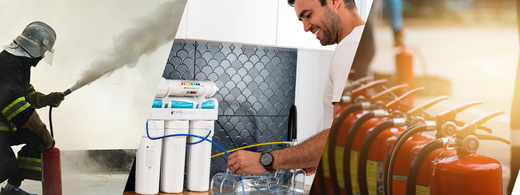Share This Story
In simple terms, PFAS (per and poly-fluroalkyl substances) are a group of compounds (e.g PFOA and PFOS) that are used to make coatings which are resistant to heat, water, oils, stains, and grease. These chemicals are also known as ‘forever chemicals’ due to the inability for them to break down naturally.
PFAS chemicals have been around for many years and have crept into our daily lives in products that use substances like Teflon, Scotchguard and Gore-Tex but also products like takeaway food packaging etc. Due to these chemicals being so prevalent in products in our daily lives, they are near on impossible to avoid. Whilst there is a chance they will make it to our drinking water, exposure to PFOS and PFOA from both inhalation and dermal routes during showering and bathing is considered negligible, as noted in the Australian Drinking Water Guidelines.
It has been widely publicised that PFAS are in fire-fighting foams that are used across the country in airports, defence force bases and other areas where fuel and oil pose a fire risk. This is because the chemicals within the PFAS family are heat resistant and often more effective in controlling a fire which contains substances like fuel and oil. The issue with the firefighting foam is that PFAS are in a concentrated form and have a much higher potential to cause harm to humans, wildlife and the environment versus a burger wrapper or waterproof jacket. When they are used, this concentrated foam runs off into the environment and ends up contaminating the ground plus ground water and/or the ocean.

What about Australian Water?
While some water that is in proximity to contaminated sites has been monitored for PFAS, this has not been done routinely for all Australian drinking water supplies.
A study of drinking water across Australia has been conducted and further information of the results can be found in the Australian Drinking Water Guidelines.
Reducing PFAS
Removing PFAS chemical variants from the environment can be difficult. However, it can be reduced from drinking water through filtration or purification means.
Granular activated carbon (GAC) and anion exchange (AIX) can remove many PFAS but are less effective at removing shorter chain PFAS, and may only be effective for a limited time. Reverse osmosis is the most reliable way to reduce both long and short chain PFAS.
Filtration:
The Pure Water Systems (‘PWS’) Hi-Tech Optimiser Cartridge (‘HTO’) will reduce 101 contaminants, including the PFAS variations PFOA and PFOS.
Learn more about the Hi-Tech Optimiser here

Purification:
As mentioned previously, reverse osmosis is the most reliable way known to be able to mostly reduce ‘forever chemicals’ from drinking water. With thousands of variations of PFAS compounds and the number growing on a steady basis, the best course of action is to use a mechanical means of purification, through reverse osmosis systems.
Shop Reverse Osmosis Water purification systems here
How can PWS help?
The PWS friendly Product Solutions Team can suggest the perfect filter system for your needs. Please phone 1300 808 966 or send us an enquiry.
Looking for further information?
For additional information, please visit the Australian Government PFAS Taskforce website: https://www.pfas.gov.au/
Figure 1: Chemical structure of PFOA, PFOS, PFBA, PFBS, PFHxS, PFNA (a) and GenX, F-53B and OBS (b).. “PFAS and their substitutes in groundwater: Occurrence, transformation, and remediation.” BentuoXua, Shuai Liub, John L.Zhouc, Chunmiao Zheng, Weifeng Jina, Bei Chene. Ting Zhangd, Wenhui Qiu. Journal of Hazardous Materials, Volume 412, 15 June 2023

References:
- https://www.pfas.gov.au/
- Australian Drinking Water Guidelines Version 3.8 P. 866 - 870
